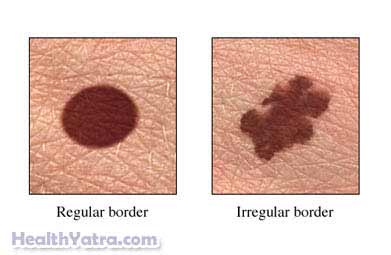Definition
Melanoma is a type of skin cancer. It is the less common form of skin cancer but it can be more serious because it is more likely to spread to other parts of the body.
Melanoma arises from the type of cells that give moles their dark colors. These cells can be found in the skin, eyes, digestive system, nail beds, or lymph nodes. Although melanoma is most common in the skin it may also arise in these other areas.
Treatment for melanoma depends on how early it is detected, or if the melanoma has spread.

Causes
Cancer occurs when cells in the body divide without control or order. Eventually these uncontrolled cells form a growth or tumor. The term cancer refers to malignant growths. These growths invade nearby tissues and spread to other parts of the body. It is not clear exactly what causes these problems in the cells but is probably a combination of genetics and environment.
Risk Factors
The most common risk factor for melanoma is exposure to ultraviolet radiation. The most common source of this radiation comes form the sun but it is also found in sun lamps and tanning booths.
Melanoma is found most often in older adults but it can happen in young adults. Other factors that increase the risk of melanoma include:
- Certain types of moles called dysplastic nevi, or atypical moles
- Large nevi present at birth
- Fair skin, freckling
- Red or blonde hair
- Light-colored eyes
- Caucasian race
- Family members with melanoma
- Excessive skin exposure to the sun without protective clothing or sunscreen
- Suppressed immune system
Symptoms
Melanomas are not usually painful. They often have no symptoms at first.
The first sign is often a change in the size, shape, color, or feel of an existing mole. Melanoma may also appear as a new, dark, discolored, or abnormal mole. Remember that most people have moles. Almost all moles are benign.
The following are signs that a mole may be a melanoma:
- Uneven shape—one half does not match the shape of the other half
- Ragged edges—ragged, notched, blurred, or irregular; pigment may spread into surrounding skin
- Uneven color—color is uneven with shades of black, brown, or tan, and possibly even white, gray, pink, red, or blue
- Change—usually growing larger, changing shape, changing color, or changing texture
- Large size—usually larger than the eraser of a pencil (5 millimeters or ¼ inch)

Diagnosis
Your doctor will ask about your symptoms and medical history. A physical exam will be done. Your doctor will look at your skin and moles. A sample of area will be removed and sent to a lab for closer examination.
Your doctor may also examine lymph nodes. Enlarged lymph nodes may suggest the spread of melanoma. A sample of lymph node tissue may also be removed for testing.
Once melanoma is found, more tests will be done to determine the stage of cancer. Melanoma is staged like other cancers, from I to IV. The stage will help determine your prognosis.
Treatment
Treatment will depend on the stage of the melanoma. Talk to your doctor about the best treatment plan for you. Treatment options may include one or more of the following:
Surgery
The melanoma and some healthy tissue around it will be removed. If a large area of tissue is removed, skin from another area of your body will be needed to cover the wound. Lymph nodes near the tumor may also be removed for testing or to stop the spread of cancer.
Chemotherapy
Chemotherapy is medication that kills cancer cells. It is used to treat advanced melanoma.
Other Medications
Immunotherapy is used to treat advanced melanoma, and melanoma that has a high risk of return. Immunotherapy trains the body’s own immune system to find and destroy cancer cells.
Some people have a genetic mutation in the BRAF gene that can cause the melanoma to grow and divide quickly. This BRAF mutation occurs in nearly half of all melanomas. Certain medications can help your body target cells with the BRAF mutation.
Radiation Therapy
Radiation therapy is the use of radiation to kill cancer cells and shrink tumors. This is not a cure for melanoma. It is used in combination with other therapies.
Prevention
To reduce your chance of getting melanoma:
- Avoid spending too much time in the sun.
- Protect your skin from the sun:
- Wear a shirt, wide-brim hat, and sunglasses.
- Use sunscreens with a sun protection factor (SPF) of at least 15.
- Avoid exposure from:
- 10:00 a.m. and 2:00 p.m. (standard time)
- 11:00 a.m. and 3:00 p.m. (daylight savings time)
- Avoid sun lamps and tanning booths.
Early diagnosis and treatment is important. Take the following steps to find melanoma in its early stages:
- See your doctor if you think you have melanoma.
- If you have many moles or a family history of melanoma, have your skin checked regularly for changes in moles.
- Ask your doctor to show you how to do a skin self-exam. Do self-exams to look for any new or changing moles.
